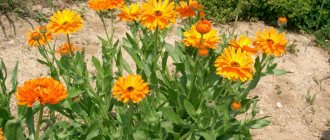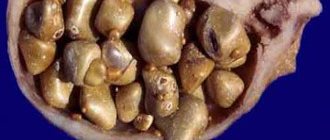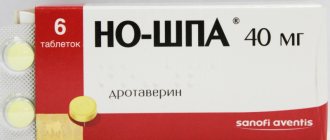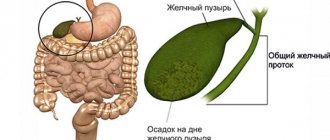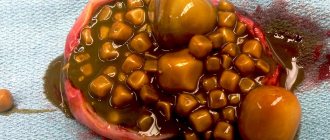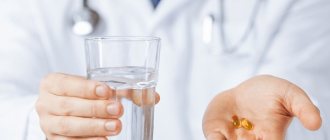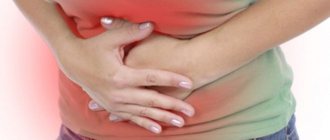Cholecystitis causes inflammation of the walls of the gallbladder. The disease has characteristic symptoms, and temperature during cholecystitis is one of the signs of the development of the pathological process. The higher its indicators, the more acute the disease. Therefore, when collecting anamnesis, the doctor must ask the patient about temperature fluctuations. Even if the fluctuations are insignificant, this fact is not ignored, since an increase in temperature means the presence of an inflammatory process in the body.
Temperature and cholecystitis
Causes of cholecystitis
Bile, produced by the liver, is involved in the digestive process. It collects in the gallbladder and is periodically expelled to facilitate digestion of food. If there is a lot of food, and it is also fatty, an increased portion of enzymes is needed to break it down, so the gall system should “work” with redoubled force. If such a load occurs rarely, the organ recovers quickly. But constant stress on the bladder can inflame it. Therefore, doctors put malnutrition as the main reason for the development of cholecystitis. The body of the bladder can become inflamed when:
- systematic consumption of high-calorie foods;
- frequent consumption of fortified or alcoholic drinks;
- irregular diet;
- endocrine diseases;
- obesity;
- hormonal imbalance;
- decreased peristalsis caused by impaired innervation of the organ;
- disruption of the blood supply to the bladder;
- helminthiasis;
- obesity;
- constant overeating.
The disease may develop as a result of other pathologies of the gastrointestinal tract (pancreatitis, gastritis, gastric ulcer), since a decrease in the enzymatic capacity of some organs of the gastrointestinal tract causes a load on others, which compensate for the lack of enzymes with their increased work. Physical inactivity and viral diseases are considered provoking factors. All of the above reasons lead to changes in the composition of bile. It becomes thick and does not come out of the bubble well. Stagnation of bile occurs, causing irritation and inflammation of the walls of the organ.
Possible complications
Refusal of treatment, irregular use of prescribed medications, erroneously selected course of treatment for cholecystitis are the main causes of complications:
- liver abscess (in the acute form of cholecystitis) - a focus with pus in the liver with a membrane of connective tissue;
- pancreatitis is an inflammatory process as a consequence of an infection in the pancreas;
- peritonitis - damage to the wall of the gallbladder and inflammation of the peritoneum;
- stone stagnation in the ducts is a complication with painful attacks in the right hypochondrium and dilation of the bile ducts.
People with bile stagnation are more prone to cholecystitis.
Causes of bile stagnation:
- ducts are compressed, with kinks;
- dyskinesia of the bile ducts and gallbladder;
- failure of motor function, bile duct tone;
- the vegetative, endocrine system works with disturbances;
- development of pathologies of the digestive organs;
- refusal to eat;
- eating too much or eating irregularly;
- inactivity;
- constipation;
- infections.
Could there be a fever?
Any inflammatory process in the body is accompanied by hyperthermia. This is how the human immune system reacts to an irritant that arises inside. Chills during cholecystitis characterize the degree of complexity of the processes occurring. The essence of the body's protective reaction is to increase the level of leukocytes and the release of pyrogens, which affect the thermoregulation center, as a result of which an increase in the threshold of body temperature is recorded. The more acute the inflammatory process, the more pyrogens are released, the more irritated the thermoregulatory center is and the higher the rates of hyperthermia.
The temperature during XX is subfibrile in nature, since the process proceeds stably, without pronounced symptoms. During the calm period, fever is not observed, and the indicators are equal to the norm. After a feast, a jump in temperature is possible, as the load on the diseased organ increases. High numbers of hyperthermia are possible if the chronic process is complicated by a gangrenous or phlegmonous (suppuration) form. In this case, fever is a symptom of the development of a critical condition. The temperature during AC reaches high limits (up to 39*), accompanied by severe chills and symptoms of general intoxication of the body.
Important! The appearance of pain and fever is a direct reason to consult a doctor.
Chronic form of the disease
Chronic cholecystitis, as a rule, develops against the background of various infections. Viruses and protozoa enter the gallbladder through the blood, lymph, or directly from the gastrointestinal tract.
One of the causes of the chronic form of the disease may be infestation by parasites. For example, giardia cholecystitis leads to severe dyskinesia of the biliary tract, accompanied by an inflammatory process and dysfunction of the organ.
If all the signs of the disease appear simultaneously and clearly, the doctor will easily make the correct diagnosis. But it happens that the symptoms of chronic inflammation are not expressed. One sign is observed, and the rest go unnoticed. In this case, the disease occurs in a latent form for a long time.
Diagnosis is further complicated by the existence of two types of chronic inflammation - acalculous and calculous. In the latter case, the clinical picture of the disease is complicated by the presence of movable stones in the gallbladder.
Forms of the disease and symptoms
Cholecystitis has two types of course - acute and chronic, each of which is characterized by certain symptoms. In the first case, the disease is hidden, and the manifestations are disguised as signs of other gastrointestinal diseases:
- dyspeptic disorders;
- headache;
- malaise;
- decreased appetite;
- fast fatiguability;
- cardiopalmus;
- indigestion;
- irritability.
In addition to general symptoms, there are characteristic manifestations:
- soreness under the right rib;
- belching with bitterness;
- hyperthermia 37-37.5*.
The pain is aching, radiating to the lower back, intensifying after eating “junk food”.
The acute form of the disease is characterized by rapidly increasing symptoms. The pain is sharp, radiating to the back, shoulder blade, epigastrium. The patient suffers from nausea, accompanied by vomiting, which does not cause relief. The acute course of the disease is accompanied by an increase in temperature to 38-39*. A common cause of the disease is an exacerbation that develops on the basis of cholelithiasis. The resulting large stones can clog the bile ducts and cause severe stagnation of bile. Overfilling of the bladder leads to a severe pain attack, as the nerve endings are irritated. The situation is considered critical and requires emergency medical attention.
Symptoms of cholecystitis
Symptoms of gallbladder inflammation
To reduce the likelihood of developing diseases of the digestive system, it is necessary to know the initial signs of inflammation of the gallbladder. This is an important organ of the digestive tract, which is involved in the accumulation processes of bile and its excretion.
Bile improves the digestibility of fats and activates the processes of moving food masses in the intestines.
Improper functioning of the gallbladder disrupts the detoxification system, as a result of which toxic substances, accumulating in the tissues after their breakdown, harm other organs.
Common anxiety symptoms
With the failure of the proper functioning of the digestive system, signs of inflammation of the gallbladder immediately begin to disturb the person. You shouldn't ignore them.
Initial signs indicating the development of the disease: a feeling of bitterness in the mouth, pain in the right hypochondrium, a feeling of nausea, cloudy urine, bright yellow color.
Main symptoms
Symptoms of gallbladder inflammation occur depending on the severity of the inflammatory process.
Acute process
With blockage of the bile drainage pathways, the walls of the organ become inflamed with the following symptoms:
- pain of a pronounced nature in the hypochondrium on the right side;
- feeling of nausea, vomiting;
- body temperature is higher than normal, chills;
- the skin takes on a yellow tint;
- constipation with gas retention as a result of intestinal failure;
- dry and coated tongue;
- low blood pressure.
Acute inflammation of the gallbladder is characterized by a highly complex course. Lack of treatment can cause peritonitis, inflammation of the ducts, liver abscessation, and inflammation of the pancreas.
Chronic process
Changes in the consistency of bile and composition, as well as disruption of its outflow, turn the process of stone formation into a chronic form.
The disease develops as a result of:
- streptococci, E. coli, staphylococci, causing intestinal infection and causing permanent gallbladder disease;
- hepatitis A;
- giardiasis of the bile ducts;
- acute cholecystitis.
A lot of fat, spices, consumed with food in youth, psycho-emotional stress provoke the onset of the disease. The formation of chronic cholecystitis takes six months or more from the onset of the disease with intermediate remission and relapse.
You can understand the development of the disease by its pronounced symptoms:
- The presence of pain of a different nature in the right side of the body, radiating to the stomach, to the left side of the hypochondrium, and the umbilical region. The pain can be paroxysmal, with high intensity, and can be felt in the lower back, shoulder blades, collarbone, and heart. Lack of diet, alcohol, stress, severe hypothermia can provoke increased pain. Instead of pain, there may be a burning sensation, heaviness in the hypochondrium on the right.
- Nausea, vomiting with bile. This is a possible result of inflammation of the gallbladder, gastritis, duodenitis, pancreatitis. The main causes of vomiting are lack of proper nutrition and alcohol abuse.
- Taste of bitterness in the mouth, belching with bitterness.
- Jaundice. A large volume of bile enters the bloodstream through impaired outflow. Skin receptors are irritated, and the patient experiences a feeling of itching throughout the body.
- The relapse period is accompanied by high fever and chills. The patient's temperature ranges from normal to high.
- With attacks of pain, irritability, nervousness, disturbing headaches, lack of sleep, increased sweating, and frequent mood swings from cheerful to depressed develop.
Most often, inflammation of the gallbladder occurs in women after reaching 40 years of age. Excess weight and a passion for high-calorie foods are factors contributing to the development of the disease.
Types of cholecystitis:
- Catarrhal - occurs in the form of an inflammatory process of the mucous surface of the gallbladder, redness, due to increased blood flow, swelling.
- Phlegmonous - with an inflammatory process of the wall layers, the gallbladder is filled with pus, consisting of dead leukocytes;
- Gangrenous – partial necrosis (necrosis) of the gallbladder.
Possible complications
Refusal of treatment, irregular use of prescribed medications, erroneously selected course of treatment for cholecystitis are the main causes of complications:
- liver abscess (in the acute form of cholecystitis) - a focus with pus in the liver with a membrane of connective tissue;
- pancreatitis is an inflammatory process as a consequence of an infection in the pancreas;
- peritonitis - damage to the wall of the gallbladder and inflammation of the peritoneum;
- stone stagnation in the ducts is a complication with painful attacks in the right hypochondrium and dilation of the bile ducts.
People with bile stagnation are more prone to cholecystitis.
Causes of bile stagnation:
- ducts are compressed, with kinks;
- dyskinesia of the bile ducts and gallbladder;
- failure of motor function, bile duct tone;
- the vegetative, endocrine system works with disturbances;
- development of pathologies of the digestive organs;
- refusal to eat;
- eating too much or eating irregularly;
- inactivity;
- constipation;
- infections.
What to do
For each case of inflammation of the gallbladder, the corresponding symptoms are individual. A patient may have only a few symptoms.
To determine the correct diagnosis, it is important to undergo an examination by a specialist, even in the presence of one symptom, providing the doctor with accurate data about the nature of the pain and the period of manifestation of signs of the disease.
The doctor, based on complaints and examination, laboratory and instrumental examination of the patient, can make an accurate diagnosis.
The doctor prescribes a course of treatment using antibiotics, drugs to relieve spasms, and painkillers.
Bed rest and diet are important components of the health complex. Self-medication for inflammation of the gallbladder is unacceptable; strict medical supervision is required to avoid possible complications in the course of the disease. Repeated inflammation of the gallbladder can begin as a result of an interrupted or erroneous course of treatment, and in this case the disease becomes more serious.
Source: https://microbiologu.ru/holecistit/simptomy-vospaleniya-zhelchnogo-puzyrya/
The second form of pathology
The catarrhal form of the disease is a type of acute cholecystitis. The pathological process is characterized by:
- pain;
- nausea;
- vomiting;
- symptoms of poisoning.
The pain attack is acute, radiating to the lower back, shoulder and shoulder blade, and the heart area. The pain is constant, intense, and there are signs of indigestion. On examination, the tongue is dry, covered with a white-yellow coating. The patient feels well, since the catarrhal form is the mildest manifestation of acute cholecystitis. There are no obvious symptoms of intoxication, heartbeat is within 70-80 beats per minute. Body temperature ranges from 37.0-37.3*. On palpation, the abdomen is soft, painful in the projection of the gallbladder, the gall sac cannot be felt. The symptoms of Ortner, Murphy, and Kehr are determined. That is, tapping the right rib and pressing in the area of the bladder increases the pain. During palpation, the patient abruptly interrupts his breath due to acute pain.
In the blood test, an increase in leukocytes and band cells is observed (not a significant shift). An ultrasound examination reveals an increase in the bile duct, a slight thickening of the walls with a decrease in echo density. If stones are present, their shadow is recorded. Catarrhal cholecystitis is treated with conservative methods.
Catarrhal gastrointestinal tract
What to do
For each case of inflammation of the gallbladder, the corresponding symptoms are individual. A patient may have only a few symptoms. To determine the correct diagnosis, it is important to undergo an examination by a specialist, even in the presence of one symptom, providing the doctor with accurate data about the nature of the pain and the period of manifestation of signs of the disease. The doctor, based on complaints and examination, laboratory and instrumental examination of the patient, can make an accurate diagnosis. The doctor prescribes a course of treatment using antibiotics, drugs to relieve spasms, and painkillers. Bed rest and diet are important components of the health complex. Self-medication for inflammation of the gallbladder is unacceptable; strict medical supervision is required to avoid possible complications in the course of the disease. Repeated inflammation of the gallbladder can begin as a result of an interrupted or erroneous course of treatment, and in this case the disease becomes more serious.
The third form of pathology
Long-term catarrhal cholecystitis, especially its calculous form, can cause a phlegmonous type of pathology, which is characterized by the formation of a purulent infiltrate and damage not only to the surface of the bladder walls, but also to deeper layers. The reason for the formation of phlegmon is the obstruction of the ducts or exit from the gall sac by displaced stones, and the addition of an infectious factor to the process. As a result, the patient's condition sharply worsens, the temperature rises from 37.5 to 38.0*, the pulse quickens to 100-120 beats.
Advice! If a patient with cholecystitis still develops a fever during treatment, then you should immediately consult a doctor, since the disease is progressing.
The patient is worried about constant nausea, repeated vomiting, which does not provide relief. The pain is intense, aching, spreading to the entire right side. The tongue is dry, coated with a yellowish coating. On palpation, the abdomen in the area of the gallbladder is tense, slightly swollen, and peritoneal irritation syndrome (Shchetkin-Blumberg) is present. An enlarged bubble or the presence of infiltration is felt under the fingers.
Laboratory tests distinguish:
- in the urine - increased levels of red blood cells, white blood cells, the presence of protein and casts;
- in the blood - high levels of bilirubin.
An ultrasound examination shows a sharply increased size of the organ body, the walls are significantly compacted. The echo density of the bubble is reduced, the “double contour” symptom is present, and the formation of an infiltrate is determined. The x-ray shows right-sided lower lobe pleuropneumonia.
Treatment is surgical. The operation is carried out on an emergency basis. Its essence is to remove the inflamed organ and prevent the development of peritonitis. The main method of performing the procedure is laparoscopic cholecystectomy. The operation is performed under general anesthesia and is one of the least traumatic methods of surgical intervention.
Phlegmonous type of inflammation
Temperature with cholecystitis
Cholecystitis causes inflammation of the walls of the gallbladder.
The disease has characteristic symptoms, and temperature during cholecystitis is one of the signs of the development of the pathological process. The higher its indicators, the more acute the disease. Therefore, when collecting anamnesis, the doctor must ask the patient about temperature fluctuations.
Even if the fluctuations are insignificant, this fact is not ignored, since an increase in temperature means the presence of an inflammatory process in the body.
Temperature and cholecystitis
Causes of cholecystitis
Bile, produced by the liver, is involved in the digestive process. It collects in the gallbladder and is periodically expelled to facilitate digestion of food.
If there is a lot of food, and it is also fatty, an increased portion of enzymes is needed to break it down, so the gall system should “work” with redoubled force. If such a load occurs rarely, the organ recovers quickly. But constant stress on the bladder can inflame it.
Therefore, doctors put malnutrition as the main reason for the development of cholecystitis. The body of the bladder can become inflamed when:
- systematic consumption of high-calorie foods;
- frequent consumption of fortified or alcoholic drinks;
- irregular diet;
- endocrine diseases;
- obesity;
- hormonal imbalance;
- decreased peristalsis caused by impaired innervation of the organ;
- disruption of the blood supply to the bladder;
- helminthiasis;
- obesity;
- constant overeating.
The disease may develop as a result of other pathologies of the gastrointestinal tract (pancreatitis, gastritis, gastric ulcer), since a decrease in the enzymatic capacity of some organs of the gastrointestinal tract causes a load on others, which compensate for the lack of enzymes with their increased work. Physical inactivity and viral diseases are considered provoking factors. All of the above reasons lead to changes in the composition of bile. It becomes thick and does not come out of the bubble well. Stagnation of bile occurs, causing irritation and inflammation of the walls of the organ.
Could there be a fever?
Any inflammatory process in the body is accompanied by hyperthermia. This is how the human immune system reacts to an irritant that arises inside. Chills during cholecystitis characterize the degree of complexity of the processes occurring.
The essence of the body's protective reaction is to increase the level of leukocytes and the release of pyrogens, which affect the thermoregulation center, as a result of which an increase in the threshold of body temperature is recorded.
The more acute the inflammatory process, the more pyrogens are released, the more irritated the thermoregulatory center is and the higher the rates of hyperthermia.
The temperature during XX is subfibrile in nature, since the process proceeds stably, without pronounced symptoms. During the calm period, fever is not observed, and the indicators are equal to the norm. After a feast, a jump in temperature is possible, as the load on the diseased organ increases.
High numbers of hyperthermia are possible if the chronic process is complicated by a gangrenous or phlegmonous (suppuration) form. In this case, fever is a symptom of the development of a critical condition.
The temperature during AC reaches high limits (up to 39*), accompanied by severe chills and symptoms of general intoxication of the body.
Important! The appearance of pain and fever is a direct reason to consult a doctor.
Forms of the disease and symptoms
Cholecystitis has two types of course - acute and chronic, each of which is characterized by certain symptoms. In the first case, the disease is hidden, and the manifestations are disguised as signs of other gastrointestinal diseases:
- dyspeptic disorders;
- headache;
- malaise;
- decreased appetite;
- fast fatiguability;
- cardiopalmus;
- indigestion;
- irritability.
In addition to general symptoms, there are characteristic manifestations:
- soreness under the right rib;
- belching with bitterness;
- hyperthermia 37-37.5*.
The pain is aching, radiating to the lower back, intensifying after eating “junk food”.
The acute form of the disease is characterized by rapidly increasing symptoms. The pain is sharp, radiating to the back, shoulder blade, epigastrium. The patient suffers from nausea, accompanied by vomiting, which does not cause relief. The acute course of the disease is accompanied by an increase in temperature to 38-39*.
A common cause of the disease is an exacerbation that develops on the basis of cholelithiasis. The resulting large stones can clog the bile ducts and cause severe stagnation of bile. Overfilling of the bladder leads to a severe pain attack, as the nerve endings are irritated.
The situation is considered critical and requires emergency medical attention.
Symptoms of cholecystitis
The second form of pathology
The catarrhal form of the disease is a type of acute cholecystitis. The pathological process is characterized by:
- pain;
- nausea;
- vomiting;
- symptoms of poisoning.
The pain attack is acute, radiating to the lower back, shoulder and shoulder blade, and the heart area. The pain is constant, intense, and there are signs of indigestion. On examination, the tongue is dry, covered with a white-yellow coating. The patient feels well, since the catarrhal form is the mildest manifestation of acute cholecystitis.
There are no obvious symptoms of intoxication, heartbeat is within 70-80 beats per minute. Body temperature ranges from 37.0-37.3*. On palpation, the abdomen is soft, painful in the projection of the gallbladder, the gall sac cannot be felt. The symptoms of Ortner, Murphy, and Kehr are determined. That is, tapping the right rib and pressing in the area of the bladder increases the pain.
During palpation, the patient abruptly interrupts his breath due to acute pain.
In the blood test, an increase in leukocytes and band cells is observed (not a significant shift). An ultrasound examination reveals an increase in the bile duct, a slight thickening of the walls with a decrease in echo density. If stones are present, their shadow is recorded. Catarrhal cholecystitis is treated with conservative methods.
Catarrhal gastrointestinal tract
The third form of pathology
Long-term catarrhal cholecystitis, especially its calculous form, can cause a phlegmonous type of pathology, which is characterized by the formation of a purulent infiltrate and damage not only to the surface of the bladder walls, but also to deeper layers.
The reason for the formation of phlegmon is the obstruction of the ducts or exit from the gall sac by displaced stones, and the addition of an infectious factor to the process.
As a result, the patient's condition sharply worsens, the temperature rises from 37.5 to 38.0*, the pulse quickens to 100-120 beats.
Advice! If a patient with cholecystitis still develops a fever during treatment, then you should immediately consult a doctor, since the disease is progressing.
The patient is worried about constant nausea, repeated vomiting, which does not provide relief. The pain is intense, aching, spreading to the entire right side. The tongue is dry, coated with a yellowish coating. On palpation, the abdomen in the area of the gallbladder is tense, slightly swollen, and peritoneal irritation syndrome (Shchetkin-Blumberg) is present. An enlarged bubble or the presence of infiltration is felt under the fingers.
Laboratory tests distinguish:
- in the urine - increased levels of red blood cells, white blood cells, the presence of protein and casts;
- in the blood - high levels of bilirubin.
An ultrasound examination shows a sharply increased size of the organ body, the walls are significantly compacted. The echo density of the bubble is reduced, the “double contour” symptom is present, and the formation of an infiltrate is determined. The x-ray shows right-sided lower lobe pleuropneumonia.
Treatment is surgical. The operation is carried out on an emergency basis. Its essence is to remove the inflamed organ and prevent the development of peritonitis. The main method of performing the procedure is laparoscopic cholecystectomy. The operation is performed under general anesthesia and is one of the least traumatic methods of surgical intervention.
Phlegmonous type of inflammation
The fourth form of pathology
The most dangerous form of acute cholecystitis is the gangrenous form of the disease.
It develops rapidly and is quite difficult to diagnose, since patients are in extremely serious condition and cannot describe their sensations.
All layers of the wall of the gall sac are involved in the pathological process, necrotic areas are formed that can rupture at any time. It is the danger of bladder perforation that puts gangrenous cholecystitis among a number of critical conditions.
The patient experiences a sharp increase in symptoms of intoxication:
- lethargy;
- headache;
- vomit;
- nausea;
- tachycardia (110-120 beats per minute);
- confusion.
Pallor and dryness of the skin are visually noted. On palpation, the abdominal wall in the hypochondrium and epigastrium is tense, the abdomen is slightly swollen, so it is impossible to palpate the bubble. Due to gangrene of the gallbladder wall, the nerve receptors die off. Therefore, the pain syndrome in such patients is reduced. There is a dull, constant pain under the right rib.
The temperature rises above 39.0*. In elderly and senile people, the classic picture is blurred and is not expressed by clear symptoms, which makes timely diagnosis of the disease even more difficult. Hyperthermia does not reach high numbers.
If, against the background of a low temperature, the symptoms of poisoning of the body are sharply expressed, it means that total necrosis of the gallbladder has occurred.
Gangrenous form
Regardless of the extent of the necrotic area, the patient undergoes surgery during which the dead areas are removed. In case of extensive gangrene, the entire bladder is removed.
Laparoscopic cholecystectomy is performed using a laparoscope and is considered the least traumatic procedure.
Since all the surgeon’s movements are displayed on the monitor using a mini video camera, the doctor controls his actions and removes only damaged tissue without affecting healthy areas.
Surgery for cholecystitis
First aid for attacks of cholecystitis
An acute attack of cholecystitis is a condition requiring hospital treatment. Emergency medical and pre-hospital care are distinguished. If an attack occurs, you should try to stop it at home, take measures that can alleviate the patient’s condition and call a medical team.
- Provide rest to the patient.
- Place the patient in the most comfortable position.
- Try to calm down.
- Place a cold compress on the right hypochondrium area. You need to keep the cold for no more than 15 minutes, then take a half-hour break. If the ambulance does not arrive, the procedure can be repeated.
- To suppress nausea, give the patient a drink of mineral water without carbon or mint tea without sugar.
- During vomiting, make sure that the patient does not have a stuck tongue.
First aid for cholecystitis
In addition to the mandatory manipulations, there is a list of actions that are prohibited from being performed during an attack.
- Give the patient any food.
- Place heat on your stomach.
- Rinse the stomach or give an enema.
- Give the patient alcohol.
- Give any medications, since their effect reduces the clarity of the clinical picture.
Having completed these manipulations, the patient urgently needs to be sent to a hospital, where he will receive qualified medical care.
A little conclusion
Can there be a fever due to inflammation of the gallbladder? Yes, this is the body’s protective reaction to emerging “problems.” Thus, the body signals about the existing inflammation. The more complex the situation, the more actively the body defends itself.
In older people, such reactions are reduced due to weakened general immunity. Therefore, with this category of patients you need to be especially careful not to miss important symptoms of deterioration.
Timely detected pathology is the beginning of successful therapy and a positive outcome of the disease.
Source: https://LechiGemor.ru/holetsistit/simptomy/10415-temperatury-pri-holetsistita-1.html
The fourth form of pathology
The most dangerous form of acute cholecystitis is the gangrenous form of the disease. It develops rapidly and is quite difficult to diagnose, since patients are in extremely serious condition and cannot describe their sensations. All layers of the wall of the gall sac are involved in the pathological process, necrotic areas are formed that can rupture at any time. It is the danger of bladder perforation that puts gangrenous cholecystitis among a number of critical conditions.
The patient experiences a sharp increase in symptoms of intoxication:
- lethargy;
- headache;
- vomit;
- nausea;
- tachycardia (110-120 beats per minute);
- confusion.
Pallor and dryness of the skin are visually noted. On palpation, the abdominal wall in the hypochondrium and epigastrium is tense, the abdomen is slightly swollen, so it is impossible to palpate the bubble. Due to gangrene of the gallbladder wall, the nerve receptors die off. Therefore, the pain syndrome in such patients is reduced. There is a dull, constant pain under the right rib. The temperature rises above 39.0*. In elderly and senile people, the classic picture is blurred and is not expressed by clear symptoms, which makes timely diagnosis of the disease even more difficult. Hyperthermia does not reach high numbers. If, against the background of a low temperature, the symptoms of poisoning of the body are sharply expressed, it means that total necrosis of the gallbladder has occurred.
Gangrenous form
Regardless of the extent of the necrotic area, the patient undergoes surgery during which the dead areas are removed. In case of extensive gangrene, the entire bladder is removed. Laparoscopic cholecystectomy is performed using a laparoscope and is considered the least traumatic procedure. Since all the surgeon’s movements are displayed on the monitor using a mini video camera, the doctor controls his actions and removes only damaged tissue without affecting healthy areas.
Surgery for cholecystitis
Temperature with cholecystitis - inflammation of the gallbladder
The temperature during cholecystitis increases against the background of inflammatory processes in the gallbladder, which are accompanied by impaired outflow of bile and the formation of stones.
A high temperature with this disease indicates pathology and requires immediate medical attention.
Diagnostics makes it possible to identify pathological abnormalities in time and prescribe the correct treatment. puzyr.info/temperatura/
- 1 Cholecystitis
- 2 Treatment methods
- 3 Diet
Cholecystitis
Inflammatory processes in the gallbladder caused by streptococcal, staphylococcal infections or anaerobic Escherichia coli are called cholecystitis.
With this disease, there is a change in the composition of bile and a violation of its outflow.
As a result, stones of various sizes are formed, which can block the bile ducts and cause complications in the form of biliary peritonitis, jaundice, liver abscess and acute pancreatitis.
Cholecystitis can occur in acute and chronic forms.
Symptoms of acute cholecystitis:
- Sharp, stabbing, burning, aching, dull, pressing pain in the right hypochondrium, which lasts about 6 hours.
- Nausea and vomiting.
- Murphy's symptom, in which there is tension in the abdominal muscles and increased pain when taking a deep breath while palpating the location of the gallbladder.
- A slight increase in temperature - 37.2 and 37.5 - indicates mild inflammation. A severe form of inflammation of the gallbladder is characterized by an increase in temperature to 40 degrees. The temperature can remain in one range and may have an abrupt character.
- Lack of appetite.
- Chills.
- Weakness, lethargy and malaise.
- Dry mouth.
- Tachycardia.
- Bloating.
- Increased liver size.
There are four forms of acute cholecystitis: catarrhal, phlegmonous, calculous and gangrenous. Elderly people experience a cardiac form of acute cholecystitis, which is accompanied by pain in the heart or behind the sternum. This pathology belongs to the atypical form.
The catarrhal form occurs at low temperature with moderate pain for 7 days. Taking medications can cure the disease, and the absence of drug treatment leads to a transition to the phlegmonous form.
The phlegmonous form of cholecystitis in most cases is a prolongation of the catarrhal or purulent form and is characterized by high fever, up to 39 degrees, severe pain, vomiting, loss of appetite and general weakness.
With the gangrenous form of cholecystitis, an increase in temperature above 39 degrees is observed.
A symptom of purulent cholecystitis is high fever. It is accompanied by uncontrollable vomiting and severe headache. A laboratory blood test reveals severe leukocytosis and an increase in ESR.
This form of cholecystitis is very dangerous.
When it is complicated, a phlegmonous and gangrenous inflammatory process is observed, which can lead to general infection of the body - pus in the blood - and result in death.
Self-medication for acute cholecystitis is strictly contraindicated. Treatment should be prescribed by a specialized specialist based on the initial examination and diagnostic data.
Prescribing the correct treatment contributes to the favorable course of the disease. After a few days, symptoms disappear in most patients. Acute cholecystitis develops as a result of cholelithiasis and often develops into chronic cholecystitis.
Symptoms of the chronic form of the disease are:
- Severe aching or paroxysmal pain on the right under the lower rib. The pain is intensified by lightly tapping the edges of the ribs with your fingertips. Increased pain is observed after eating fatty or fried foods, alcohol, as well as after physical activity and stressful situations.
- The feverish state is accompanied by chills and profuse sweating.
- Belching and vomiting with the presence of bile in the vomit.
- Bitterness and dry mouth.
- Itching and rash on the skin. These symptoms occur when bile acids enter the bloodstream and irritate nerve endings and skin receptors.
- Jaundice occurs due to an increased concentration of bile acids in the blood.
- Mood swings.
- Headache.
- Leukocytosis.
- Sleep disturbance.
- Abnormal bowel movements (alternating diarrhea with constipation).
- The increase in body temperature reaches 40 degrees.
Cholecystitis can be acalculous and calculous. Calculous cholecystitis is a consequence of cholelithiasis and the result of metabolic disorders. Stones consist of bilirubin, calcium and cholesterol. During normal functioning of the gallbladder, they are removed from the body with feces through the intestines.
When there is a complication in the functioning of the bile organ, hepatic colic appears, which occurs when a stone enters the bile ducts. The calculus obstructs the flow of bile, and bile acids enter the blood, causing jaundice. The symptoms of hepatic colic are similar to acute cholecystitis, but have more severe pain. There is a need for emergency hospitalization of the patient.
Acalculous cholecystitis occurs when the gallbladder becomes infected.
Chronic cholecystitis can last for many years. Lack of timely treatment leads to shrinkage of the diseased organ and loss of its characteristic functions. High-quality treatment and adherence to dietary nutrition allows you to get rid of the symptoms of the disease for a long period.
Causes of the disease:
- sedentary lifestyle, sedentary work;
- chronic diseases: sinusitis, tonsillitis, cystitis, prostatitis, pyelonephritis;
- bacterial infections;
- infection with helminths (ascariasis, giardiasis);
- congenital pathologies of the gallbladder;
- poor nutrition and chaotic eating patterns;
- stress and emotional stress;
- hormonal disorders;
- stagnation of bile caused by dyskinesia of the bile ducts, physical exertion or pregnancy;
- abdominal trauma;
- dysbacteriosis;
- allergy;
- low level of immunity;
- obesity;
- pathological processes in the pancreas and liver.
The incidence of cholecystitis in women is several times higher than the incidence rate in men. This is due to the peculiarities of hormonal metabolism during menopause and pregnancy.
Female sex hormones have a negative effect on the function of the gallbladder. An imbalance of bile acids and cholesterol causes compression of the walls of the gallbladder during pregnancy.
As a result, bile stagnation occurs.
Young children are also susceptible to this disease. It may be a consequence of a congenital anomaly of the gallbladder and its ducts. Improper nutrition of a nursing mother is a provoking factor for cholecystitis in the baby.
The cause of an infectious inflammatory process of the gallbladder can also be dirty hands, which the child often puts in his mouth.
A high temperature indicates intoxication of the body and requires urgent placement of the child in the inpatient gastroenterology department.
The acute form of cholecystitis requires adequate therapy. In its absence, the disease becomes chronic with periods of exacerbation and remission. The involvement of other organs in pathogenesis leads to treatment difficulties. The result of an advanced form can be the development of gangrene, bile fistulas that communicate with the kidneys, intestines and stomach with the gallbladder, acute pancreatitis and sepsis.
Treatment methods
Treatment methods for acute and chronic cholecystitis are selected individually based on laboratory data and ultrasound results and depend on the degree of exacerbation of the disease. The period of exacerbation is characterized by similarity of symptoms with other acute diseases: appendicitis, pancreatitis, pyelonephritis.
Diagnostics are necessary to confirm the diagnosis and prescribe the correct treatment:
- Using ultrasound, the volume and size of stones, their location and the degree of threat to the patient are determined.
- Blood and urine tests can reveal inflammation associated with the formation and movement of stones.
- Determination of congenital pathological changes in the gallbladder and bile ducts is possible with X-ray irradiation.
- Probing allows you to study the biochemistry of bile.
Treatment of cholecystitis consists of a set of measures aimed at relieving pain and getting rid of symptoms of the disease, and includes taking medications, following a special diet and doing physical therapy.
Conservative treatment involves taking medications:
- antibiotics. Treat inflammation and help reduce fever: Levofloxacin, Ofloxacin, Erythromycin, Clarithromycin, Norfloxacin, Doxacycline;
- antispasmodics. Relieve spasms and eliminate pain: No-shpa, Baralgin, Duspatalin, Papaverine, Odeston, Platifilin;
- choleretic drugs. Promote the outflow of bile and prevent stagnation: Cholenzym, Allohol, Holagol, Gepabene, Tanacehol, Flamin;
- hepatoprotective drugs. Protect cells from negative effects and promote regeneration: Festal.
The use of traditional medicine speeds up the healing process. Medicinal herbs have healing (fennel, mint, lavender, calendula, chamomile, caraway, sage) and choleretic (St. John's wort and corn silk) properties. Decoctions and infusions are made from them and used during exacerbation of the disease.
Traditional medicine effectively eliminates the causes of cholecystitis, has a minimum of side effects, contains a maximum of vitamins and is low in cost. Availability of treatment is not a guide to action. Herbal medicines should be prescribed by a specialist, taking into account the individual characteristics of the body and the stage of the disease.
Taking vitamins increases the body's protective functions and strengthens resistance to negative factors.
Surgical operations are necessary for serious disorders of the gallbladder and complete dysfunction of the organ, when conservative treatment methods do not bring the expected effect, as well as when there is a threat of death.
Cholecystectomy is performed immediately if symptoms of peritonitis and bile obstruction are detected.
In the treatment of cholecystitis, the drug Ursosan, which dilutes bile, is very popular. It has immunomodulatory activity and reduces immunopathological reactions in the liver, dissolving and removing cholesterol stones from the body and preventing the formation of new ones. Ursosan reduces the absorption of cholesterol and promotes the elimination of toxins.
First aid for attacks of cholecystitis
An acute attack of cholecystitis is a condition requiring hospital treatment. Emergency medical and pre-hospital care are distinguished. If an attack occurs, you should try to stop it at home, take measures that can alleviate the patient’s condition and call a medical team.
- Provide rest to the patient.
- Place the patient in the most comfortable position.
- Try to calm down.
- Place a cold compress on the right hypochondrium area. You need to keep the cold for no more than 15 minutes, then take a half-hour break. If the ambulance does not arrive, the procedure can be repeated.
- To suppress nausea, give the patient a drink of mineral water without carbon or mint tea without sugar.
- During vomiting, make sure that the patient does not have a stuck tongue.
First aid for cholecystitis
In addition to mandatory manipulations, there is a list of actions that are prohibited from being performed during an attack.
- Give the patient any food.
- Place heat on your stomach.
- Rinse the stomach or give an enema.
- Give the patient alcohol.
- Give any medications, since their effect reduces the clarity of the clinical picture.
Having completed these manipulations, the patient urgently needs to be sent to a hospital, where he will receive qualified medical care.
Stopping an attack
When severe pain occurs in the right (less often left) hypochondrium, it is necessary to urgently stop the attack before it develops and provokes a cardiac failure. At home you can take painkillers: Baralgin, Analgin, Pantalgin . But after taking a painkiller, you need to urgently consult a doctor (it’s better to call an ambulance), since the slightest delay can cost not only your health, but also your life.
Doctors usually prescribe antibacterial treatment and rehabilitation. Antibacterial treatment consists of concentrating the bile level and eliminating the source of inflammation. For this purpose and to eliminate pain syndromes, anticholinergic drugs ( Riabal , etc.), antispasmodics ( Papaverine, Mebeverine ), analgesics and anticholinergics are prescribed. If the presence of large stones (more than 2-3 mm) is not observed, choleretic agents are prescribed, both chemically ( Allohol, Cholenzym ) and herbal medicine ( elecampane, yarrow , etc.).
Herbs
Herbal treatment occupies an important place in the treatment of the biliary tract. It is the active substances contained in elecampane, yarrow, immortelle and other herbs that are an excellent analogue of medications and even act more effectively, without causing such significant side effects as pharmaceutical drugs. But treatment with herbs should be treated with the utmost caution, having first consulted with a doctor regarding the choice of herbs and dosage. Otherwise, you can seriously harm yourself.
A mixture of immortelle (15 g) and St. John's wort (10 g) has a good effect on the condition of the liver and gall bladder. Dry herbs are poured with half a glass of warm water and boiled in a water bath for 5 minutes, then filtered. The infusion should be drunk half a glass three times a day 15-20 minutes before meals.
An infusion of the herb corn silk has a similar effect of improving bile secretion. 10 g of herbs are poured into a glass of warm water and, as in the first case, boiled in a water bath for 5 minutes. The infusion is taken a quarter glass three times a day before meals.
Diet
Diet also plays an important role in the treatment of cholecystitis. Fried food should be replaced with boiled, stewed or steamed food; alcohol, tobacco and hot spices should be completely abandoned. It is important that the diet is fractional, not plentiful, consisting of five meals in small portions.
The diet must include lean fish and chicken, fiber, greens, porridge, and grain bread. Proper nutrition in combination with herbal medicine and exercise will help to significantly improve the condition of the liver and gallbladder and avoid such unpleasant consequences of the onset of cholecystitis as surgical intervention.
Signs of chronic inflammation
The clinic of permanent malaise is characterized by signs of a long course towards progression with periodic exacerbations. The characteristics of the disease are determined by the presence of inflammation in the gallbladder and a disorder in the function of bile flow into the duodenum due to developed dyskinesia.
Pain syndrome
It is the feeling of pain that is the main sign of malaise. Localization, intensity and duration of sensation depends on:
- type of bile duct dyskinesia;
- the presence of additional abnormalities in the gastrointestinal tract;
- formation of complications.
Chronic acalculous pathology is characterized by painful sensations in the area of the left side or in the pit of the stomach. At the same time, the patient notices that they become more intense and longer after festive feasts, drinking alcoholic or carbonated drinks, or active physical activity.
Typically, pain with cholecystitis is continuous, aching. In some cases, it may be associated with a feeling of heaviness in the liver area.
When various complications occur, the pain becomes stronger and changes its location. With uncomplicated inflammation, they radiate only to the right upper part of the body: shoulder, shoulder blade or collarbone. Developed complications can provoke constant painful sensations, which become stronger during bending or twisting of the body. Strong swings of the right hand can also cause discomfort.
If the patient ignores painful attacks and does not consult a doctor, chronic cholecystitis can provoke the growth of stones in the gall bladder.
Dyspepsia
Cholecystitis usually leads to digestive disorders. They are expressed by constant heartburn, belching of rotten eggs (even on an empty stomach), and a feeling of bitterness in the mouth.
The patient complains of flatulence, abdominal distension, diarrhea or constipation. Nausea and bitter vomiting are much less common. If atony or hypotension of the gallbladder is observed, vomiting alleviates the patient’s condition, relieving the attack and the feeling of heaviness in the side.
Hypertensive dyskinesia is characterized by increased pain after vomiting. In this case, the vomit contains some bile. The stronger the stagnation of bile, the more of it is found in the contents of the stomach.
Vomiting often occurs due to non-compliance with the prescribed diet, sports activities or emotional stress.
In case of dyspepsia, special attention should be paid to the condition of the stool. Its density and frequency of urges often indicate the occurrence of complications or the formation of secondary endemics.
One of the reliable signs of cholecystitis can be the color of the stool. The color of excrement in pathology is most often light, sometimes completely white. This is explained by the small amount of bile entering the duodenum.
Intoxication of the body
During an exacerbation of the disease, a typical sign of the inflammatory process appears - a rise in temperature. Usually it does not exceed 38°C, but with exacerbations of the disease or the development of complications it can reach 40°C.
A rise in body temperature, accompanied by profuse sweating and chills, is observed against the background of purulent inflammation of the gallbladder.
In exhausted and elderly people, the temperature can remain normal even in the case of purulent cholecystitis. This is explained by the reduced adaptation of the weakened organism to the environment.
In addition to the signs discussed above, which are characteristic of all groups of the population, there are a number of symptoms that are characteristic only of a certain group of patients.
For example, in allergy sufferers, gallbladder disease almost always causes skin itching and hives. Quincke's edema may occur.
It is impossible not to mention the typical symptoms of cholecystitis in women who have crossed the 50-year mark. In this case, disruptions occur in the functioning of the vegetative-vascular and endocrine systems, and in the psycho-emotional state. Symptoms of PMS appear:
- depression, bad mood, tearfulness and irritability;
- migraine;
- swelling and tenderness of the mammary glands;
- swelling of the face and hands;
- numbness of the limbs;
- constant changes in blood pressure.
Very often, premenstrual syndrome does not appear as a hormonal ailment, but as one of the symptoms of cholecystitis. You must be able to distinguish them from each other.
All characteristic signs of PMS appear a few days before the onset of the regulation and disappear immediately after their arrival.
